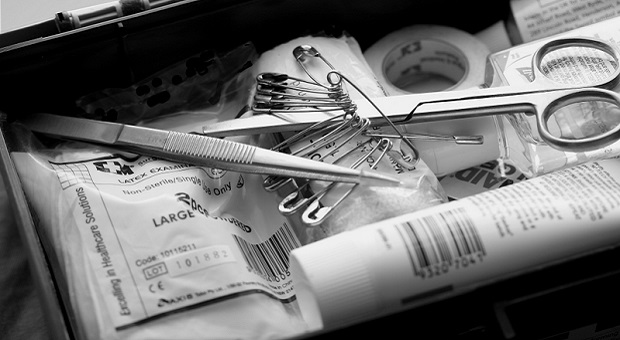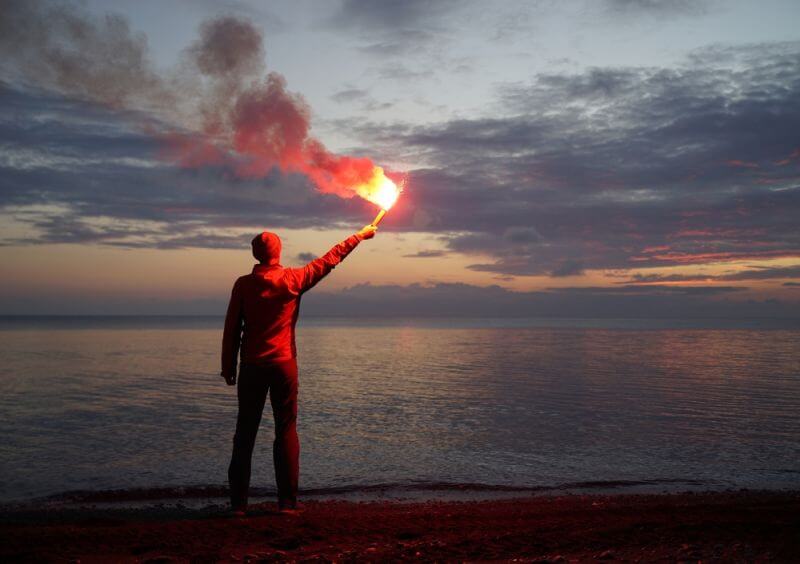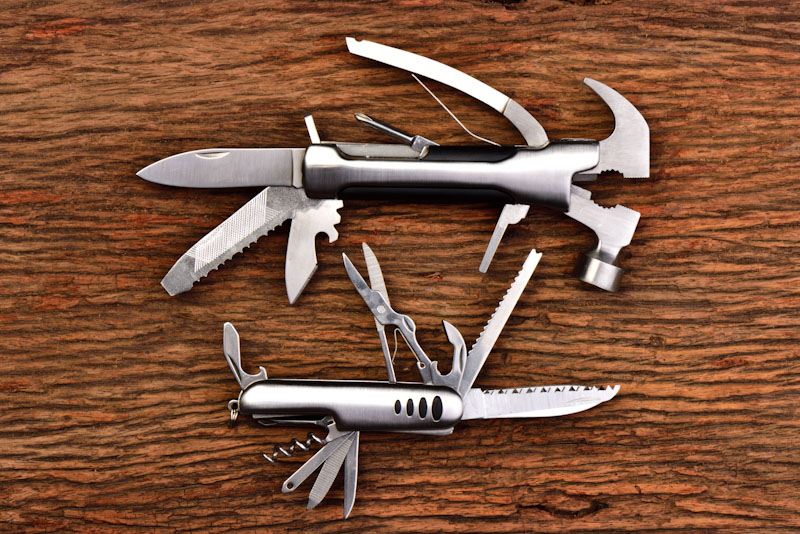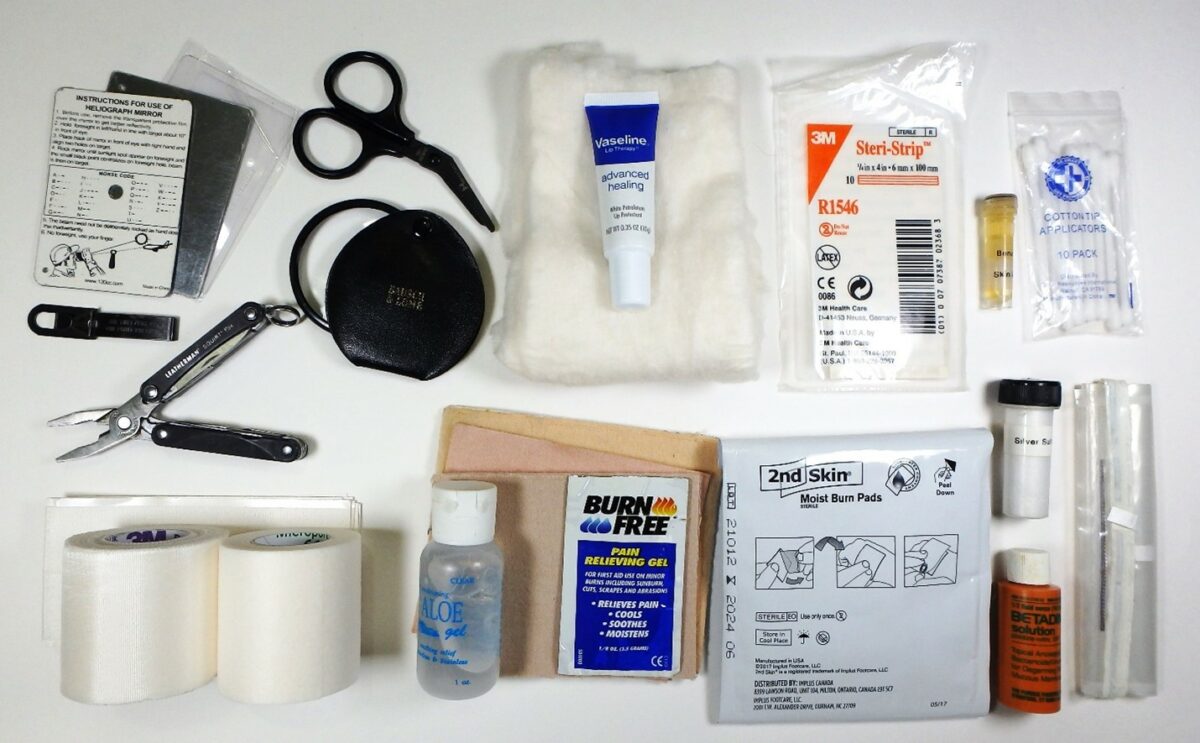The importance of a well-stocked first aid kit is a point that cannot be stressed enough. Aside from the fact that, ideally, one should always have such a kit on hand for common ailments like minor cuts, burns, bruises and abrasions, your first aid kit becomes a matter of critical importance in the event of any serious emergency or natural disaster.
In emergency situations, a properly prepared first aid kit can literally mean the difference between life and death for you or your loved ones, but the sad fact is that most people don’t even have a first aid kit in their home anymore.
In an era of widespread hospital and clinical care facilities, most families keep a box or two of bandaids on hand and a tube of Neosporin, but not much else.
But when real emergencies happen or natural disasters strike, those care facilities are quickly overwhelmed and unable to deal with everyone who needs care.
Luckily, you can protect yourself, your family and your loved ones from going without basic medical necessities in times of crises by simply investing a bit of time and money in a high quality, well-stocked first aid kit.
A good first aid kit can be assembled one piece at a time, and generally at a pretty reasonable cost. Building your own first aid kit, as opposed to purchasing one of the ready-made kits that are widely available, has some additional advantages, too.
Not only will you save money, but you’ll also know precisely what you packed since you’ll have picked out each item. Packing your own kit also means you can include any specific medications that you or your family may require in an emergency, an important consideration that no ready-made kit can ever provide for.
What To Pack
All first aid kits can be personalized to contain specific things you or your family might need in an emergency, but here’s a list of some of the most common and fundamental items that your first aid kit should contain:
- Medical sutures; these are used for applying stitches and can usually be obtained at a pharmacy or online for a fairly reasonable price. You can also get sutures from most vets.
- Antiseptic; this might be something as simple as Neosporin or Tea Tree Oil, but liquid iodine serves phenomenally as a topical antiseptic; it can also be used to purify water.
- Bandages, including bandaids of a variety of sizes, non-stick gauze bandages of various sizes and elastic Ace-style bandages for treating or securing sprains.
- Arm splints; even if you just include a few sturdy, light-weight lengths of wood ( 8 – 12 inches will do) including some form of splinting material is a good idea. Broken arms, wrists and fingers can happen rather easily, and a splint goes a long way toward stabilizing, relieving pain and fostering healing of such wounds.
- Scissors, a good, sturdy pair of scissors and possibly also a finer, ultra-sharp pair of surgical scissors, for use cutting bandages down or for other emergencies.
- Pain medication, generally an over-the-counter medication such as acetaminophen (Tylenol) or aspirin; note that aspirin has marked blood-thinning effects, however, so acetaminophen may be a preferable medication to use in emergencies.
- Prescription medication for yourself or any family members. At least a one week supply of necessary medication should be stored in your first aid kit at all times. Most prescription medication has a long shelf-life, but be sure to change the medication out periodically to keep it fresh; most doctors have no problem with you filling an extra prescription specifically for the purpose of saving it in case of an emergency.
- Emergency tourniquet; this is used to stop bleeding by cutting off the blood flow, generally for use on an arm or leg when there is substantial blood loss from a wound. A tourniquet can be made from a cord or even a torn piece of cloth, but emergency tourniquets are available that resemble a traditional blood pressure cuff.
- Medical (adhesive) tape, this goes with the bandages mentioned above, particularly in the case of gauze bandages when you will need something to adhere them over a wound.
- Burn salve or aloe vera for the treatment of burns is an excellent, necessary item for any first aid kit; you may also include special dressings for burns, and colloidal or ionic silver has been used in hospital burn wards for decades.
- Ammonia inhalants, commonly known as smelling salts, are a useful addition to a first aid kit but should be used with caution. Smelling salts are used to help wake someone up who has passed out, fainted or become unconscious for some reason; when the reason for unconsciousness is unknown, it may be advisable to wait before using smelling salts. Note: ammonia inhalants can be particularly aggravating to the lungs and respiratory system, so individuals with known respiratory illnesses should avoid their use.
- A thermometer; a traditional thermometer will seldom lead you wrong, but if you use an electronic one instead just be sure to pack extra batteries in your kit for it. Don’t underestimate the value of a thermometer in an emergency; running a fever or becoming chilled can be deadly in a survival situation.
- Tweezers are immensely useful, especially if you have to clean out a wound.
- Eye drops or other neutral fluid intended for flushing and rinsing the eyes; a 4 oz. bottle is generally sufficient.
- Instant ice / instant heat packs can provide the heating or the cooling necessary to reduce swelling, alleviate pain or warm you up accordingly; they are light weight and very affordable, available in outdoors stores as well as online.
- Rubbing alcohol for use in sterilizing needles, sutures, medical tools and wounds.
There are many other items that you might choose to pack in your first aid kit, such as antihistamines if you or your family members are known to suffer from allergies. Whether you buy a preassembled kit or create your own, be sure to familiarize yourself with all the contents of your first aid kit and specialize it to the known medical needs of your family ahead of time.
This article has been written by Gaia Rady for Survivopedia.
Disclaimer: The opinions voiced by Gaia Rady, are her own and are not meant to take the place of seeking medical help from your healthcare provider. The practice of medicine without a license is illegal and punishable by law. Seek modern and standard medical care whenever and wherever it is available.









Crystal Hayward | May 3, 2013
|
I also have been buying up hydro procide. it’s usualy reasonable. Use it for mouth wash too, can be used for tooth ache also.
Kenner Peterson | May 3, 2013
|
Thanks for the good information. May we all thrive and survive.
Jane Nowlin | May 3, 2013
|
I really hate to second guess people who write articles like this but I disagree with so many of the choices the writer makes. I’m a retired emergency room nurse and I wish I had the space to put down what I think is the problem with this list. Particularly the recommendation of including suturing materials. And Iodine as an antiseptic. But then that’s just my opinion
Eric James Sr. | May 3, 2013
|
please don’t think you can only post one time please if you have knowledge share . I’m completely knew to this . But I’m diving head first . so please share . Thank you and God Bless
JD61 | May 3, 2013
|
@ Jane, If you feel this list is wrong and you have many years experience as an ER nurse how about sharing a list of what you feel would be better in a “survival” first aid kit.
JRS | May 3, 2013
|
ER medicine is totally different then survival medicine. The items listed are OK for starters. A medical survival kit can include items not used in the ER room. In a survival situation if you have to suture, then do it. If there is no disinfectant then you do your best. My guide is a Navy medical corps bag adjusted to my needs.
Bill Ellis | May 3, 2013
|
I carry a triple antibiotic with pain killer in the ointment. Very useful when in the wilderness or hours from help as in caving. It can mean the difference between calling out a rescue and doing a self-rescue.
Tim | May 3, 2013
|
I will use whole cloves for severe tooth pain. Put clove in mouth by tooth that’s in pain, it will cease to hurt. It works !!!! Trust me, I know!
Lou | May 8, 2013
|
The willow tree inner bark, is it just what is right under the outer bark? How best do u harvest it?
Barbara | May 21, 2013
|
I’ve not actually done this, but I’ve read that you have to scrape it out. Can be used on burns and inflammation sites. The capsules can be opened an mixed with water and is essential for stomach problems, i.e., like severe viruses that affect digestion. My 1 yr old came down with a virus contracted at my daycare. She was becoming dehydrated but refused even liquids. Two trips to the ER offered no help. I mixed several capsules with water to a consistency of a pudding. She literally grabbed my hand as soon as she smelled it. I was shocked! She wanted more. The second dose did the trick. Talk about a miracle. Anyone with IBD, Crohn’s Disease, diverticulitis, etc., this is a must. Can also be used externally for burns.
Jud brown | May 3, 2013
|
I think steristrips & a stapler would be a better choice than sutures for most. Also, ibuprofen instead of acetaminophen as it serves dual purpose as an anti-inflammatory. Last, how about adding Imodium and doxycycline to the list.
Randy k | May 3, 2013
|
All first aid kits need a “snake bite kit” This could save your life even if you are hunting, minding your own business, going for a walk in the woods, even sitting around under a tree enjoying a glass of tea. Snakes are everywhere in the lower forty-eight. Snake bite kits are usually less than $12.00. Great investment!
Doug | May 3, 2013
|
Instead of wooden splints, I would suggest packing SAM splints. (splint aluminum maliable) They roll up like a ace bandage and you don’t have to worry about them breaking.
To use one, roll it out place it along and form it around the injured lim.
jan | May 3, 2013
|
My father had once told me that for a toothache, once while he was ‘on the road,’ he swished whisky in his mouth, and it was a definite pain reliever.
jan | May 3, 2013
|
I’d like to add to what my father said about swishing whiskey in his mouth, that he was not close to a town where there was a dentist, and didn’t recommend it as a regular practice.’ But in ‘desperate times, (which is what we are, i presuming we are talking about here, we take necessary measures.
Anita cleveland | May 3, 2013
|
I appreciate all of your articles, especially since I am a “newbie.” I guess there
are many things experienced survivalists could add to this article, and it would be helpful to us newbies. But I really wish those of you who have some specialized knowledge–like you, Jane Nowlin,–would let us have it, too :). I can offer one little bit about the prescription meds, because I live with a pharmacist. If you have health insurance that covers your drugs, check with the insurance company before having your doctor write an extra prescription.
Most insurance companies do not cover any more than your regular supply, although some will let you get a “vacation” coverage. Of course, you can always pay cash, but it also depends on what the drug is. Extra controlled substances may not be allowed, no matter what, as a matter of law. Best of all,
just talk to your pharmacist. He or she knows more than your doctor does
about drugs, anyway.
Bill sHOOTER | October 12, 2013
|
Within allowable & customary guidelines, a physician may be willing to write a prescription for a larger amount than the two of you agree will actually be used on the promise that the additional medication is for a ‘stash’ and not to be dispensed or sold to others. It is then your responsibility to keep track of inventory and rotate it to keep ALL the meds fresh.
Then, too, if you doubt the physician’s willingness to cooperate, convince them that you actually need more to obtain the desired results.
Alternatively, if you are taking ‘forever’ medicine, you may find that you can cut your dosage. Have a trusted someone monitor you while you experiment, a little at a time, to watch for adverse changes you may not notice yourself. (With so much of the nation on mood-altering prescription meds, this advice makes good sense.) Bank the accumulating excess.
These steps are unethical and probably illegal. You are responsible for your own actions.
If you lack for inspiration, ask an alky or a druggie how they manage to maintain a supply.
steve spencer | May 3, 2013
|
As a retired Fla. firefighter- medic, I have a couple of issues with the article. 1st, a little medical knowledge is THE most important item to have. Advanced 1st aid course or better yet, an EMT course, is essential before you start advising people
to include suture kits. And inhalants?, forget ’em! Other than that, some useful info. My fellow posters also had some great suggestions.
Bill sHOOTER | October 12, 2013
|
Start with CPR / AED course. It’s short, inexpensive, reasonably easy, and gets you mentally primed for successively more detailed courses.
lillian g. | May 3, 2013
|
I include feminine napkins they come individually wrapped & one can cover a good sized wound. No mess w/cutting gauze. Added padding helps cushion area.
skip | May 3, 2013
|
Tampons are sanitary and great for absorption with bullet wounds.
Carol Messina | May 4, 2013
|
Thank you so much for this info shared so freely. It is a wonderful service.
Bob | May 4, 2013
|
Hydrogen Peroxide doesn’t keep its potency long. I’d stock a small amount of such items, determine where to get them quickly, and get a lot when a problem looks imminent.
Dennis Kramer | May 4, 2013
|
There should also be small paperback books or manuals about First Aid perhaps one on medicinal uses of plants.Example: Inner bark of any willow tree has the same active ingredient as asprin.
Bill sHOOTER | October 12, 2013
|
I’d like to add that the worst time to read such books is after the emergency arises. There is a reason we call them “emergencies”.
Scott | May 5, 2013
|
I like this list for Emergency First Aid kits.
It assumes your far from professional medical treatment and in those cases when a person needs stitches to close a gaping wound and a tourniquet could potentially cause loss of limb, it’s a great addition.
I also like the Feminine Pads addition to the list.
My Personal Emergency Kit includes “Crazy Glue” instead of sutures. It is after all for reasons unknown that you might need to patch the skin back onto the person. We are talking about times when you need to save a life rather than Best Practice.
My Emergency Kit contains the following:
Rubber Gloves, 70% rubbing alcohol, Cotton balls and Swabs, Iodine,
Crazy Glue, pointed Scissors, pointed Tweezers, single edge Razor Blades, Sterile Plastic Tube, tourniquet with 1 wooden dowel ( for tightening ), 24″ x 3/8″ Surgical hose, Magnifying Glass, Ibuprofen, Ipecac ( to induce vomiting ), 24″x 24″ sterile cotton cloth in vacuum seal bag, Various bandages and band-aids, Neosporin, bicarbonate of soda, Salt, Fire making Kit, Fishing Kit, small blanket, Flares and a Mirror. I also have Medical Emergency guide book in the kit for those that have courage to step in for FirstAid but don’t know where to start.
While I know my kit should include a snake bite kit, I hadn’t included it but likely will. I should probably add a roll of Duct Tape as well, along with Emergency HAM radio and a Light source such as those new Flash Lights you shake and never needs batteries.
bm | May 8, 2013
|
don’t forget activated charcoal.in bulk or capsules for food poisonings, snake bite, making poultices for spider bites etc. or make your own, build a hot fire with wood in a seal able container, burn down to hot coals. smother. next day blow off ash grind in blender, strain and bottle. it works.
radarphos | May 8, 2013
|
At age 59 I began taking short-acting (no residual) generic ritalin (methylphenidate, 20mg tablets), to help me maintain focus. I began taking 1/4 tab (5mg) in the morning (I still only take that amount and not more, and I don’t take my prescribed dosage of two pills per day (40mg/day). My first surprise was how it slightly elevated my mood (I was more upbeat, but not “high”), and it helped me maintain focus when I performed a task that I dreaded and despised (digging out tree roots on my knees). Not only was I able to stay on task for 4 hours without even noticing how long I was working, but before I took ritalin my patience tolerance for that task was one hour at most. Several times; the same effect; and in fact, every time I take it, my experience is the same. Here is my point. Germany invented this stuff during one of the World Wars, to give to soldiers. Both World Wars were high stress times for German soldiers. Any disaster BI or BO will also be high stress. People who already have some difficulty staying focused ought to be generally burned out by the flood of thoughts they experience as they enter the Go-Now phase of a disaster, etc. Whoever experiences anxiety that is too high, is not going to get moving very fast; and that person will need some help. An easy med help is ritalin. Staying focused to the most essential tasks of the moment is critically important in a real disaster. Second point, MD’s will gladly prescribe ritalin to older people with mild or subtle depression, and anyone who has some difficulty maintaining focus. Further, plenty of kids and grandkids have taken and may still be taking ritalin. It may be easy to get several pills from relatives to check this out for yourself, for e.g. at 1/4 pill dosage. You may get some to keep on hand in your BO med kit, if you predicted that your anxiety levels would interfere with your ability to immediately respond to crisis tasks as you need to do so; or if you have difficulty maintaining focus (due to your mind being flooded with too many thoughts, which sometimes is called “brooding”). These pills are the size of baby aspirin. Ritalin is worth investigating as a preparation aid. I take mine “prn”, which means “as needed, or as one might request it”. My habit is to take none for 2 weeks to 2 months, until I begin to realize that I am not very productive because of being distracted by too many thoughts (things I should be doing). Then I start taking it for a couple days and experience my productivity level increase by about four times, after which I stop taking them because my thoughts are more calmed and no need exists. My conclusion for me is that I will include a few tabs of ritalin in all my BO bags. My opinion is that everyone’s anxiety will be running high (which can be a good thing so long as it is manageable) in a real HTF situation. Where it is not manageable, ritalin is a med that can help. My opinion about older folks is that we cannot really know what causes our mind to wander as we age. Is it age? Is it a slightly depressed mood? Is it a chemical imbalance? Who knows? After 60 years, people have already proven themselves in many capacities of living. Does it really matter to take (part of) a prescription pill, when it benefits you by helping you to stay focused and while it boosts your mood a bit so that you want to stay focused and do what you need to do? I’m glad it is available. Coffee (caffiene) does me well too, until I go through the coffee crash, or begin to run to the bathroom every fifteen minutes. There is no crash with Ritalin at the dosage I take (in the morning). Best wishes.
judith | October 23, 2013
|
I had a severe reaction to sting from a jelly fish and was almost comatose. Poison control told us to make a paste out of rubbing alcohol and meat tenderizer and apply it. It began to work, immediately, and in a few hours I was back to normal. I have thought that this might work on other bites and stings.
Pingback:How to Make an Emergency Preparedness Kit | October 24, 2013
|
Frank l. | December 10, 2013
|
I want to thank everyone for their helpful comments. I’m an old guy now, but a former trained paramedic going back 38 years and new technology has made great leaps in the EMS community, which I’m glad to see and endorse. I recommend the Swayer Bite & Sting Kit. It is a universal kit for all kinds of stings and bits. It has a suction device proven to remove snake venom. Treating snake bits really depends on where the bite is. Treating low ankle bits are not as bad a bit in the muscle are (like the calf area) where blood circulation is more prominent, which quickly circulate mush faster. After using the extractor (please read the ample instructions in the kit.) I would recommend using a compression technique over the bite to further slow the venom that the extractor was not able to remove. Please keep in mind, time is of the essence. Additionally, I’m building my first aid kit piece by piece. There are plenty of websites that you can purchase from and the pricing is fair. I recommend that you write down and keep the inventory list with your kit. Since you don’t use your kit everyday, it is easy to forget what you have. Keep your inventory list in categories and separated as such in your kit, so when an emergency hits you’ll know where everything is placed in your kit at the ready. Many of you have mentioned items I have not thought of, so thank you all very much for your suggestions. I better get back to work. My kit is growing very large and I need to find a bag to accommodate my collection. I would appreciate any recommendations. Let’s all keep this in mind that we are all in this together. We are truly helping each other. Not one person knows more than all of us together. Stay safe and well……and God bless, Frank, Wylie, TX
water removal services | January 16, 2014
|
Do you mind if I quote a few of your articles as long as I provide credit and
sources back to your site? My blog site is in
the exact same niche as yours and my users would
truly benefit from some of the information you present
here. Please let me know if this alright with you.
Many thanks!
admin | January 16, 2014
|
Quoting articles is ok as long as you provide credit and sources back to our website, as you said.
J billy | February 22, 2014
|
Great list but ima add a few things.
I have a lot of this in my kit. A few things I have that was not posted was
Multi tool
Para cord tied around my bags handle ( u can YouTube a video to see how to secure it by wrapping it)
Flash light and pen light
Emergency water bags. They are 250ml and used for drinking or cleaning
Poncho for chest wounds. Plastic is very important
Cold compress
Clot packs
My bag is small but has a lot in it. I spent around $150 putting it together and it can handle minor cuts up to life threatening injuries and trauma care. Of course remember ABC. Ambulance before cruiser. Call for help before treating serious wounds and week professional medical help as soon as possible
Pingback:Essential Survival Items for Your Everyday Carry Bag | June 23, 2014
|
Pingback:Prioritizing On A Budget | Survival skills, survival guns, survival guide | November 13, 2014
|
Pingback:Survival Skills To Learn From Eskimo People - Bio Prepper | February 18, 2016
|
Pingback:Stocking Your First-Aid Kit - US Crisis PreppersUS Crisis Preppers | March 24, 2016
|
Stacey Fitzpatrick | September 12, 2016
|
Thanks for great suggestions.
Pingback:50 Things To Stockpile On A Budget This Fall | Survivopedia | October 4, 2016
|
Pingback:How To Survive When SHTF At Work | Survivopedia | September 3, 2018
|